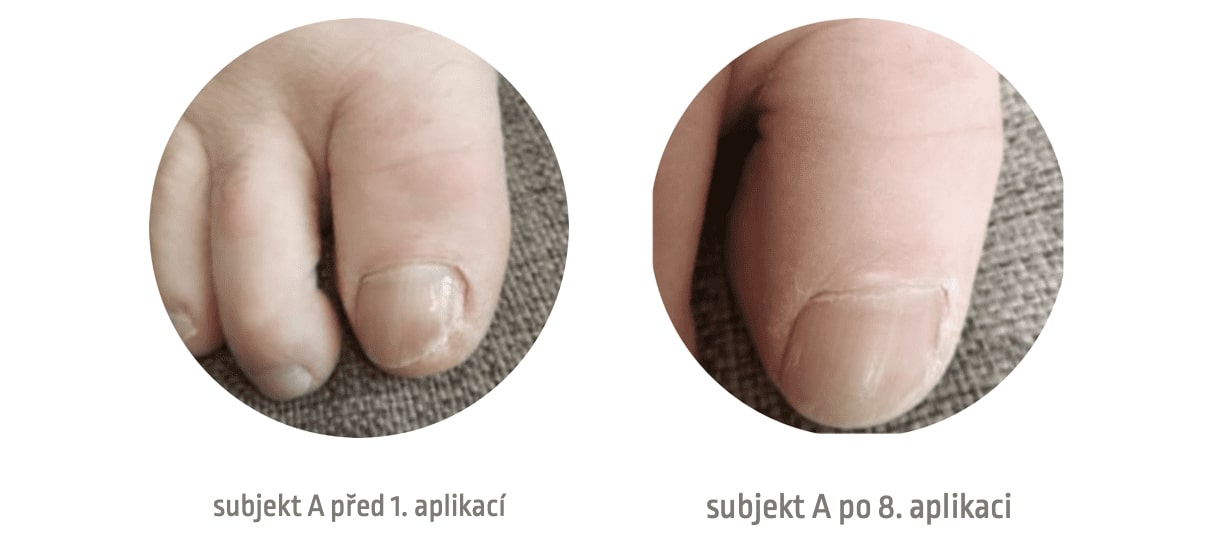Dealing with toenail fungus, also known as onychomycosis, can be a persistent and frustrating concern for many individuals. Recognizing the signs of skin and nail mycosis is crucial for timely intervention. This article aims to provide comprehensive guidance on the best fungal nail infection treatments, offering insights into how to get rid of toenail fungus permanently. From understanding foot and toenail fungus symptoms to exploring nail fungus treatments, we delve into practical solutions for effectively combating this common yet bothersome condition.
.jpg)
Risk Factors That Promote the Growth of Nail Fungus Include:
- age over 60 (older people have a weakened immune system),
- long-term use of closed shoes (without adequate air circulation, a warm and moist microclimate is established, ideal for the growth of fungi - a warning symptom is the smell of feet),
- weakened immunity due to illness or certain procedures (risky patients are transplant recipients who take immunosuppressive drugs),
- restricted blood flow (often as a result of diabetes),
- barefoot walking in public pools, locker rooms, etc.,
- damage to the nail, for example during a hike.
How to Recognize Skin and Nail fungus
At first, it can be difficult to recognize nail fungus because the skin is only reddened and itchy. Typical symptoms include thickening of the nail and a change in color to yellow. The nail is brittle and, with advancing mycosis, it crumbles and - depending on the type of fungus - changes color to green, white, or black. In some cases, the entire nail plate can be separated from the bed.
Fungi also attack the skin around the nails and between the toes. Here, the infection is manifested by drying, reddening, and "scaling" of the skin. Blisters also appear, which can burst. In advanced onychomycosis, an odor develops and the nail grows over. Patients with nail fungus are sometimes troubled by pain when walking.
If you do not treat the fungus, it can lead to permanent damage to the nail, spread of infection further into the body, or secondary infection (invasion of bacteria into the irritated skin). All this can lead to amputation of the affected fingers or even life-threatening septic shock.
The Most Common Symptoms of Foot and Toenail or Fingernail Fungus
- Thickening of the nail,
- changes in the color of the nail (yellow, green, white, and black),
- reddening and scaling of the skin,
- itching,
- blisters.
Where Does Fungal Nail Infection Occur? Classification According to Types of Mycosis
Mycosis on the Feet
If the fungus appears on the feet, it is the most common dermatophytosis. These occur in up to 50% of the population and unfortunately often return to patients. It is manifested by reddish skin between the toes, which is itchy and cracking. If the problem progresses to foot mycosis, cracks also form on the soles of the feet.
Nail Fungus – Nail Mycosis (Onychomycosis)
As mentioned above, typical symptoms include thickening of the nail and a change in color to yellow. In advanced stages, the nail crumbles and changes color to green, white, or black. In some cases, the entire nail plate can be separated from the bed. The infection usually affects the toenails, but it can also spread to the fingernails.
Scalp Fungus: Mycosis of the Scalp (Tinea Capitis)
It is a common fungal infection of the scalp and hair, usually caused by fungi of the genus Microsporum or Trichophyton. It is characterized by the appearance of round patches of hair loss and the presence of pustules and crusts on the scalp. It mainly affects children, but can also occur in adults.
Beard Fungus: Mycosis of the Beard (Tinea Barbae)
Mycosis of the beard, also known as tinea barbae, is a fungal infection of the beard area. It is caused by fungi called dermatophytes, which feed on keratin, the protein that makes up the hair and nails. Symptoms of tinea barbae include red, itchy patches on the beard, and the hair may break off at the surface of the skin, resulting in small bald spots. In severe cases, the infection can spread to the surrounding skin, causing redness, swelling, and blistering.
Treatment of tinea barbae usually involves the use of antifungal medications, such as terbinafine or itraconazole, which are applied directly to the affected area. The affected area should also be kept clean and dry, and any infected hair should be cut off. In severe cases, oral antifungal medication may be necessary. It is important to continue treatment for the recommended amount of time to prevent the infection from coming back.
Treatment of Nail and Foot Fungus
An apple cider vinegar bath is effective for treating onychomycosis in the early stages. To prepare it, add two tablespoons of apple cider vinegar and several grains of potassium permanganate to a basin of warm water. Soak your feet for 10 to 15 minutes. Some people recommend replacing the vinegar with several drops of bleach (e.g. Savo), but this can be dangerous - it's best to avoid this option.
The most effective drugs for treating nail fungus contain antifungal agents such as Lamisil, itraconazole or fluconazole. These substances accumulate in the nail bed, prevent the growth of spores, and disrupt the metabolism of yeasts and fungi, causing them to die. The disadvantage of systemic drugs is their side effects, which can have a negative effect on the liver.
For less serious cases, doctors prescribe creams with cyclopirox. However, these preparations require a prescription, which can take several weeks to obtain. If you can't wait to see a dermatologist, you'll have to look for over-the-counter preparations.
Over-the-Counter Preparations for Nail and Skin Fungi
Popular products are those with biocompatible nanofibers that coat the nail and gradually release active ingredients over a period of up to two weeks. These include the colorless nail polish FRANAIL with oregano and aloe vera extracts. These extracts contain compounds such as carvacrol, thymol, and bradykinase that have:
- antimycotic and antibacterial effects (helpful against secondary infection)
- healing properties
- preventive effects (prevent the development of fungi)
Before applying, it is necessary to remove the nail polish. It is enough to cut the affected nails after applying the polish. One bottle will last for 6 to 10 applications on all nails.

It is a fungal infection of the beard area, usually caused by fungi of the genus Trichophyton. It is characterized by the appearance of red, inflamed and itchy patches on the beard and mustache area. It mainly affects adult men with a beard.
Keep in mind that it will take several weeks to months to treat onychomycosis. You need to wait until the infected nail grows out. During treatment, wear new shoes that you spray with a silver-based disinfectant at least twice a week.
#produkty#https://www.nanospace.store/search/?string=franail
Best Prevention of Nail and Feet Fungus
The ideal way to prevent foot and nail fungus is to wear shoes with adequate air circulation, but this is not always possible. At the very least, change your shoes regularly and make sure they are completely "aired out" before wearing them again.
Socks made of silver fibers can help prevent the growth of fungi and spores. Silver nanoparticles can also help suppress bacteria and prevent odor (you can read more about silver nanoparticles in this article).
Be careful not to transmit fungal spores through other means - don't try on shoes without socks and never use someone else's towels. We also recommend supporting the treatment of onychomycosis by taking supplements to boost your immunity.
Takeaway
Onychomycosis is a fungal infection that usually affects the toenails. Risk factors for the development of the disease include advanced age, excessive sweating of the feet, and long-term use of closed shoes.
There are several types of mycoses depending on the part of the body they affect.
- Diabetics, people with impaired immunity, and transplant recipients are extremely susceptible to the development of nail fungus.
- During onychomycosis, the nail changes color, thickens, and gradually crumbles. Fungal infection of the skin is characterized by redness and scaling.
- If nail fungus is not treated, the nail bed will grow over, causing pain and secondary infection. In rare cases, onychomycosis can lead to septic shock.
- The most effective drugs for nail fungus are terbinafine preparations. Creams with cyclopirox also work well. These preparations require a prescription.
- Over-the-counter products for treating nail fungus include colorless polishes that contain nanofibers with oregano and aloe vera extract. The effect of these polishes is long-lasting, releasing active ingredients for up to 14 days after a single application.
Sources
-
Gupta AK, Versteeg SG. Successful treatment of onychomycosis with a homeopathic remedy. Dermatol Online J. 2019;25(3):1-4. PMID: 30982374.
-
Aditya M, Bhatia A, Perween A, et al. Herbal remedies for onychomycosis: a review. Biomed Pharmacother. 2018;107:1692-1702. doi: 10.1016/j.biopha.2018.08.031. Epub 2018 Aug 16. PMID: 30114743.
-
Chassagne F, Huang X, Lefebvre A, et al. In vitro antifungal activity of herbal remedies commonly used in the treatment of onychomycosis. Phytother Res. 2018;32(8):1461-1467. doi: 10.1002/ptr.6115. Epub 2018 Apr 27. PMID: 29701256.
-
Aridogan IA, Bayram E, Hancioglu S, et al. Terpinen-4-ol, the main component of Melaleuca alternifolia (tea tree) oil inhibits the in vitro growth of human melanoma cells. J Invest Dermatol. 2002;119(3):681-7. doi: 10.1046/j.1523-1747.2002.01846.x. PMID: 12230594.
-
Kim SH, Kim JG, Kim IH. Effects of garlic extracts on fungal growth, aflatoxin production, and metabolism of aflatoxin biosynthetic pathway. J Food Prot. 2007;70(4):888-92. doi: 10.4315/0362-028x-70.4.888. PMID: 17477281.
-
Singh G, Kumar P. Evaluation of in vitro antifungal activity of various plant essential oils against dermatophytes. J Essential Oil Bearing Plants. 2012;15(3):480-486. doi: 10.1080/0972060X.2012.10644217.
-
Khorsandi K, Mousavi SH, Akbarzadeh A. In vitro antifungal activity of some medicinal plants against Trichophyton spp. Jundishapur J Microbiol. 2012;6(8):e7045. doi: 10.5812/jjm.7045. PMID: 23456083.
-
Zin NM, Abdul Hamid A, Osman A, Mohamed S. Antifungal activity of the essential oils of nine Zingiberaceae species. Pharm Biol. 2011;49(12):1268-75. doi: 10.3109/13880209.2011.582516. PMID: 21838760.
-
Shahverdi AR, Monsef-Esfahani HR, Tavasoli S, et al. Trans-cinnamaldehyde from Cinnamomum zeylanicum bark essential oil reduces the clindamycin resistance of Clostridium difficile in vitro. J Food Sci. 2007;72(7):S055-8. doi: 10.1111/j.1750-3841.2007.00424.x. PMID: 17995828.

